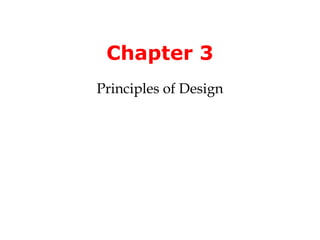
Chapter3
- 1. Chapter 3 Principles of Design
- 2. Design or Composition • Design or composition - the act of organizing the visual elements to effect a desired aesthetic on a work of art. • When artists create compositions they consciously draw upon design principles. • Sometimes, however, they may choose to consciously violate them.
- 3. UNITY • A work or art achieves unity when its parts seem necessary or balanced to the total composition.
- 4. Examples of Unity • Grid • Color harmony • Keeping one or more aspects of the work constant • Continuity
- 5. Fig. 3.1, p.70 ANDY WARHOL Ethel Scull Thirty-Six Times (1963). Synthetic polymer paint silkscreened on canvas. 79-3/4” x 143-1/4”.
- 9. Types of Unity • Visual Unity - Artwork that is unified by color, shape, composition, or some other visual design principle • Conceptual Unity - Artwork that has a common theme or concept throughout it
- 19. Emphasis on Variety • When artists emphasize variety, they are usually exaggerating differences rather than similarities.
- 22. BALANCE • Balance refers to the distribution of weight in art • The actual or apparent weight in the elements of a composition • Balancing the formal elements of art
- 23. Actual Balance and Pictorial Balance 1. Actual Balance means that the piece of art is literally balanced. It can stand upright on its own. 2. Pictorial Balance refers to the distribution of the apparent or visual weight of the elements in works that are basically 2D.
- 28. Symmetrical Balance • Symmetry - refers to a similarity of form or arrangement on either side of a dividing line or plane • Symmetrical Balance - the whole of the work has a symmetrical feeling • Asymmetrical balance - when the variations to the right and left side of the composition are more then slight, yet there remains an overall sense of balance
- 29. Fig. 3.8, p.75 LEONARDO DA VINCI. Proportion of the Human Figure (after Vitruvius) (c. 1485–1490). Pen and ink. 13-1⁄2” x 9-3⁄4”.
- 30. Fig. 3.9, p.75: The United States Capitol Building, Washington, DC.
- 39. Asymmetrical Balance • When the right and left sides of a composition bear visibly different shapes, colors, textures, or other elements, and yet they are arranged or “weighted” in such a way that the work feels balanced.
- 47. Horizontal, Vertical, and Radial Balance Horizontal balance - Elements on the left and right side of the composition seem to be about equal. Vertical balance - The elements at the top and bottom of the composition are in balance Diagonal balance - The elements on either side of a diagonal line dividing the composition are visually equal. Radial balance - Design elements radiate from the center point; frequently used in ceramics, jewelry, basketry, stained glass, and other crafts
- 48. Imbalance • Can create shock and discomfort • Can be used to capture a sense of movement
- 53. Fig. 3.17, p.79 ROBERT CAPA. Death of a Loyalist Soldier (September 5, 1936). Gelatin silver print.
- 54. EMPHASIS AND FOCAL POINT • Some feature of a work normally will capture the viewer’s attention. • Artists use emphasis to focus the viewer’s attention.
- 55. How to create a focal point: • Accentuating certain shapes • Intensifying color • Using directional line • Strategically placing objects and images • By isolating an object or subject
- 71. RHYTHM Regular Repetition or Rhythm - orderly progressions • Rhythm can move a viewer visually as well as emotionally. • Repetitive pattern can be used to lead the eye over the landscape of the work. • Rhythm is found in sound, nature, architecture, and art.
- 77. SCALE • Scale refers to size. • Scale - The relative size of an object compared to other objects of its kind, its setting, or human dimensions.
- 78. Fig. 3.25, p.84 COUNT DE MONTIZON. The Hippopotamus at the Zoological Gardens, Regent’s Park (1852). Salted-paper print.
- 79. Hierarchical Scaling • Used as a way of indicating importance • Bigger = more import • Often used in Ancient and Medieval art
- 81. Distortion of Scale • Altering the viewer’s sense of scale can create visual shock and humor. • Can challenge the viewer to rethink the subject and the historical aspects of the object